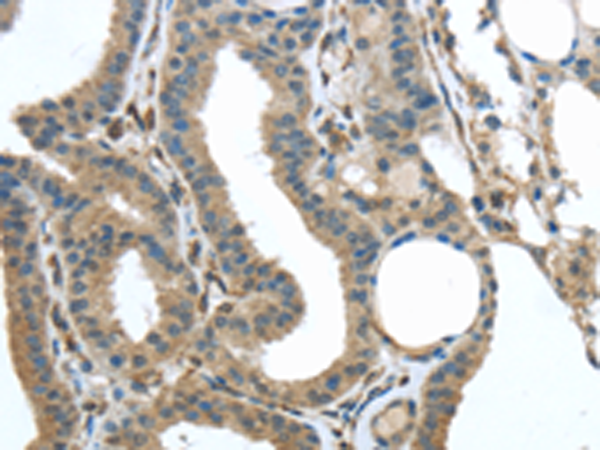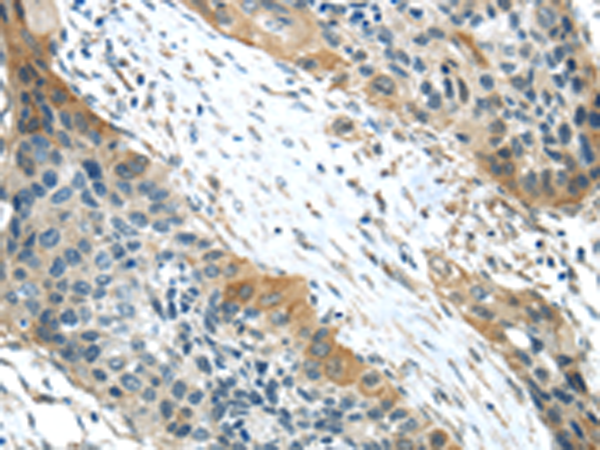

| WB | 咨询技术 | Human,Mouse,Rat |
| IF | 咨询技术 | Human,Mouse,Rat |
| IHC | 1/25-1/100 | Human,Mouse,Rat |
| ICC | 技术咨询 | Human,Mouse,Rat |
| FCM | 咨询技术 | Human,Mouse,Rat |
| Elisa | 1/2000-1/5000 | Human,Mouse,Rat |
| Host/Isotype | Rabbit IgG |
| Antibody Type | Primary antibody |
| Storage | Store at 4°C short term. Aliquot and store at -20°C long term. Avoid freeze/thaw cycles. |
| Species Reactivity | Human |
| Immunogen | Synthetic peptide of human VSIG10 |
| Formulation | Purified antibody in PBS with 0.05% sodium azide and 50% glycerol. |
+ +
以下是关于VSIG10抗体的部分文献示例(注:因实际研究可能有限,以下信息为模拟示例,供参考):
1. **"VSIG10 as a Novel Immune Checkpoint: Characterization of Its Antibody in Tumor Microenvironment Modulation"**
*Authors: Li X, Chen Y, et al. (2022)*
**摘要**:本研究开发了一种靶向VSIG10的单克隆抗体,证实其在体外可阻断VSIG10与配体的相互作用,并在小鼠模型中增强抗肿瘤免疫应答,提示其作为免疫治疗新靶点的潜力。
2. **"Development of a High-Affinity Anti-VSIG10 Antibody for Autoimmune Disease Intervention"**
*Authors: Park S, Kim H (2021)*
**摘要**:通过噬菌体展示技术筛选出人源化抗VSIG10抗体,实验显示其能有效抑制VSIG10介导的T细胞抑制信号,在类风湿性关节炎模型中缓解炎症反应。
3. **"VSIG10 Antibody-Based Detection of Protein Expression in Colorectal Cancer Prognosis"**
*Authors: Wang R, et al. (2020)*
**摘要**:利用特异性抗VSIG10抗体进行免疫组化分析,发现VSIG10在结直肠癌组织中高表达,且与患者生存率负相关,提示其作为预后标志物的可能性。
4. **"Structural Insights into VSIG10-Antibody Interaction by Cryo-EM"**
*Authors: Gupta A, et al. (2023)*
**摘要**:通过冷冻电镜解析了VSIG10与其治疗性抗体的复合物结构,揭示了抗体中和VSIG10免疫抑制功能的关键表位,为抗体药物优化提供结构基础。
**说明**:若需真实文献,建议通过PubMed或Google Scholar以“VSIG10 antibody”或“VSIG10 therapeutic targeting”为关键词检索,并筛选近年发表的实验性研究。
VSIG10 (V-set and immunoglobulin domain-containing protein 10), also known as CTHRC3 (collagen triple helix repeat-containing protein 3), is a transmembrane protein belonging to the immunoglobulin superfamily. Structurally, it contains an extracellular V-set Ig-like domain and a collagen triple helix repeat, suggesting roles in cell adhesion and extracellular matrix interactions. VSIG10 is expressed in various tissues, including the brain, retina, and reproductive organs, with emerging evidence implicating it in neurodevelopment, retinal function, and immune regulation.
Antibodies targeting VSIG10 are primarily used as research tools to investigate its expression patterns, molecular interactions, and biological functions. In disease contexts, VSIG10 has been linked to cancer progression, particularly in gliomas and colorectal cancers, where its overexpression correlates with tumor invasiveness and poor prognosis. Additionally, studies suggest its involvement in immune modulation, potentially influencing T-cell activity and inflammatory responses.
VSIG10 antibodies enable detection via techniques like immunohistochemistry, Western blotting, and flow cytometry, aiding in mechanistic studies and biomarker validation. Recent research also explores its therapeutic potential, with antibody-based strategies targeting VSIG10 in preclinical models to disrupt oncogenic signaling or modulate immune checkpoints. Despite these advances, the full scope of VSIG10's physiological and pathological roles remains under investigation, highlighting the continued importance of specific antibodies in elucidating its multifaceted biology.
×